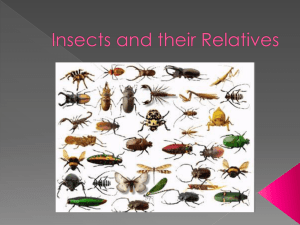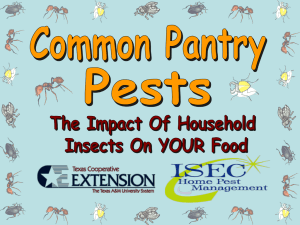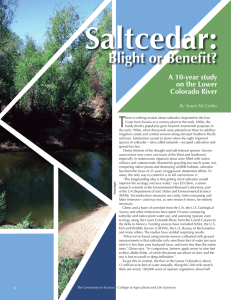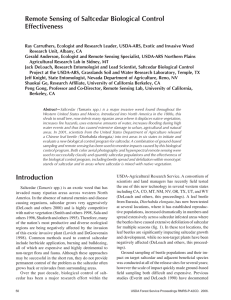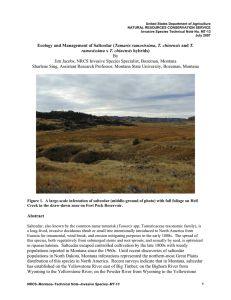Insects as a Means of Controlling Invasive Plants
advertisement
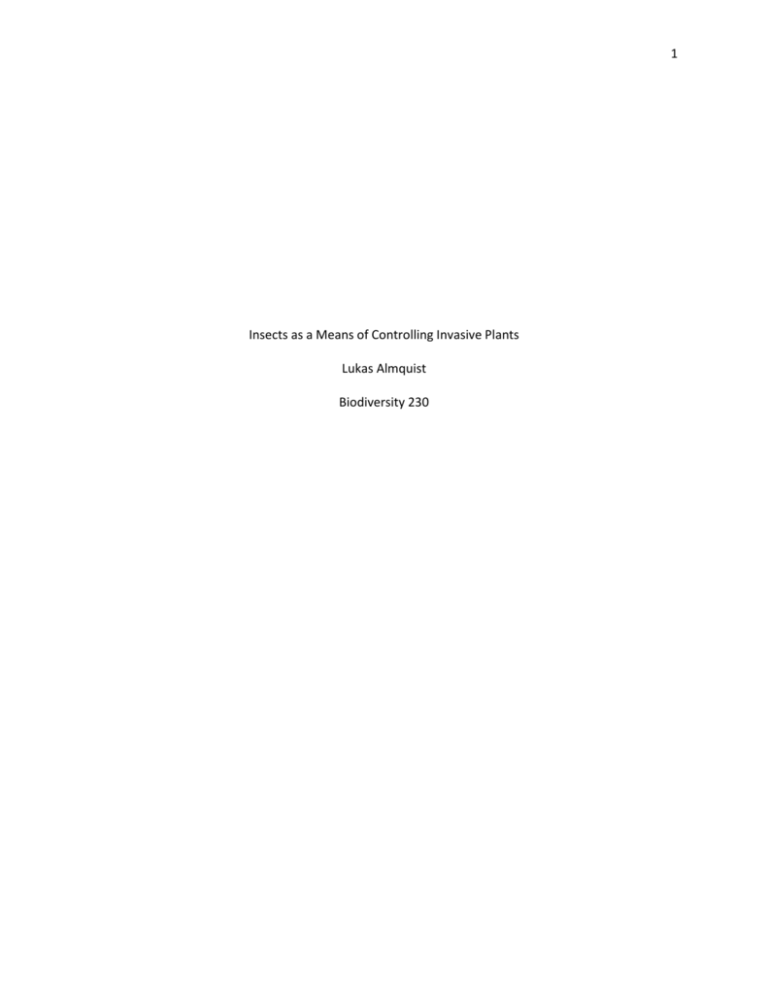
1 Insects as a Means of Controlling Invasive Plants Lukas Almquist Biodiversity 230 2 Insects are the most numerous class of living organisms on the planet. However, their beneficial impacts toward human populations go largely unseen or understood by most. One of the most beneficial roles insects play is a natural biological control against other animals that compete with humans for resources to survive and reproduce, commonly referred to as “pests”. Invasive, non-native plants are major pests that governments across the world spend extraordinary amount of time and resources on eradicating. Invasive weeds cost U.S. consumers and producers billions of dollars every years. These invasive pests affect food production, native biodiversity, and sometimes even environmental aesthetics. Living organisms have been used to control pests for hundreds of years. Insects were responsible for saving Southern California’s citrus industry in the early nineteen hundreds when the Vedalia beetle was introduced by University of California scientists to control the Cottony Cushion Scale devastating the area. Modern biological weed control aims “to achieve and maintain low population levels of the weed and to foster replacement of the weed with more desirable vegetation” (McEvoy, Cox, and Coombs, 1991). Due to the importance and effectiveness of insects as a biological control of other animals, it is also necessary to consider insects as a means of controlling invasive plants. It must first be considered why the agricultural and forestry industries in the United States view invasive plants as “pests”. Industrial globalization has gone a long way in improving the health and food production of human populations, but along with the global transfer of information and valuables came the movement of plants, animals, and viruses. Many exotic plants and animals in the United States today were brought here intentionally by humans for purely aesthetic reasons. Other species piggy-backed on these valuable organisms or arrived across seas unnoticed in the ballast water of ships. Regardless of how the species arrived, however, most invasive plants share a series of characteristics that allow them to flourish and compete directly with humans. Firstly, these exotic plants produce many offspring with little care provided for the individual offspring. Often the exotic species is native in a different climate 3 with a shorter growing season than the region it is introduced to, again allowing it to flourish. They also often have successful dispersal mechanisms that are very attractive to wildlife. Some demonstrate alleleopathy, in that they produce chemicals that inhibit the growth of other plants nearby (Waldbauer 2003). Perhaps the largest downside to exotic plant species is biotic pollution, or the loss of biodiversity in a region due to its introduction and dominance of native species. Genetic variability is extremely important in ecosystems, and it must also be remembered that when a native species is lost, so are the organisms that depend on that native plant for survival and reproduction. The final characteristic, and the one which we take full advantage of through biological control methods, is the lack of native predators, pathogens, and diseases that would normally keep the plant’s population numbers in check. This is why research aimed at identifying natural enemies in the exotic species’ native range is so important. (Cox, 1999) With new, innovative research being conducted every day, insects are becoming an increasingly viable alternative to herbicides in plant control. Synthetic chemical herbicides have been the most widely used method of controlling pest weeds since industries developed methods for large scale production and synthesis of chemicals between World Wars I and II. Some pests cannot be controlled by chemicals or have become genetically resistant to herbicides after generations of treatment. In addition, chemicals cannot be used to control plant viruses and pathogens, which are often most effective in controlling large plant populations. (Hajek, 2004) The human health and safety aspects of synthetic chemical herbicide use were not considered very widely before the publication of Rachel Carson’s Silent Spring, a documentation of the harmful effects of the pesticide DDT on bird populations (Hajek, 2004). Now that it is understood more fully that herbicides affect native plant and animal populations as well as change the chemical composition of human environments, insects are becoming the rational choice for the biological control of invasive plants. There are several case studies in the western united states 4 that verify the effectiveness of insects as a natural alternative to herbicides and as an economical tool for the long-term control of weeds. First, the biological control of St. John’s Wort in Humbolt California will be considered. St. John’s Wort is an invasive plant that was first seen in Pennsylvania in 1793. By the 1940’s, this pest was ravishing farmland vegetation at an alarming rate. The plant’s yellow flower made it aesthetically valuable, but this same flower is somewhat toxic and caused cow’s that were feeding on it to lose weight. Free of natural predators, St. John’s Wort crowded out native forage plants, greatly depreciating farmland in the area. The pest was spreading so fast that “by 1945 this aggressive weed had spread to nearby states and Canada, and over 7,700 square miles- an area about the size of New Jersey- was heavily infested and almost useless for grazing” (Waldbauer, 2003). Entomologists were soon on a quest to find a natural species that fed on St. John’s Wort. University of California entomologists obtained three species of exotic phytophagous beetles from Australia in 1945. Not long after the beetles’ release in Northern California, the species Crysolina quadrigemina emerged as the most effective insect of the three at controlling the invasive St. John’s Wort. By the 1960’s the Crysolina beetle had reduced the plant to “less than one percent its former abundance” (Waldbauer, 2003). The success of the Crysolina beetle in controlling St. John’s Wort in California is indicative of the usefulness of insects in biological control, and has yielded small, sustained population of Crysolina and the wort. This is an example of biological control before modern science. To see how much the United State has developed scientifically to utilize insects on a larger scale requires a look at modern U.S. agriculture’s use of foreign agents imported for weed control. Today in the United States, “about two dozen U.S. quarantine facilities serve as strictly regulated highways for importing biological control agents” (Stelljes and Wood, 2000). The U.S. Agricultural Research Service has been partnering with universities and other federal agencies to quarantine, organize, and administer insects upon approved weeds. The ARS has assisted in many cases across the 5 western United States, and “since 1945, more than 110 insect species have been released in the continental United States and Hawaii against some 57 weeds” (Stelljes and Wood, 2000). Another modern case of biological control involving insects occurred with the invasive ragwort in Oregon. Ragwort is a biennial plant from Norway that causes economic loss in the United States by displacing desirable foliage and poisoning livestock. The first biological control introduced by scientist was the cinnabar moth from France, released in Northern California in 1959 by the USDA (McEvoy, Cox, and Coombs, 1991). The larvae of the moth successfully fed on the ragwort in its vegetative stages when it is most vulnerable to control methods, but the larvae prefer when the plants are flowering. While the moth “partially” controlled the weed, it often “developed secondary flowering shoots from July through October” due to limited larval feeding and therefore avoided complete control. In response to this, the USDA released another insect, the Ragwort flea beetle in 1969. The adults of the beetle chew holes in ragwort leaves and their eggs are laid on the plant. The larvae burrow into the xylem and phloem of the leaves and roots, feeding immediately upon emergence. According to the study, the action of the moth and flea beetle to together have successfully led to “the persistence of moth, beetle, and ragwort populations at very low density; and the replacement of ragwort with more desirable vegetation”(McEvoy, Cox, and Coombs, 1991). Therefore, this application is now considered a successful case of biological control using insects. Scientists may encounter a variety of difficulties during the biological control process and must adapt their methods to the ecology of the target ecosystem. The biological control of saltcedar using Chinese beetles is an example of the ingenuity of scientist in their approach . First used for erosion control in western states since the mid- 1800’s, the saltcedar had since crowded out native trees like willows in riparian habitats. The ARS launched a project to control the pest in 1987. Several potential natural enemies from China, France, Israel, and even Kazakhstan were studied and later identified as potential natural enemies of the saltcedar. A leaf beetle called Diorhabda elongata feeds on saltcedar 6 leaves from its grub stage to adult, defoliating the tree and preventing it young and adults on saltcedar from performing photosynthesis and obtaining nutrients (Stelljes and Wood, 2000). Indirectly, by damaging the trees foliage, the beetle is also made the tree vulnerable to disease-causing fungi or bacteria. The beetle was approved in 1999 and several individuals were placed in cages so their consumption rate of the saltcedar leaves could be observed and recorded. However, this was a unique case as “saltcedar replaced native willows that an endangered birdthe southwestern willow flycatcher- relied on for nesting” (Stelljes and Wood, 2000). In light of this information, scientists did not release the control insect directly into designated sites. Instead, it had to be determined by scientists the rate at which the control species would defoliate the saltcedar before the insects were placed directly on site to feed. In this manner, they avoided killing the saltcedar stands faster than the endangered species of bird could adapt to nesting in native trees again. The case of the willow and the flycatcher is an example of the plasticity of nature as opposed to its fictional fragility. Environmental systems are by no means as fragile as humans tend to make them out to be. The niches within natural habitats change in response to shifts in climate or new disturbances like an introduced species. Therefore, there is a potential for using insects as biological control agents to alter the native ecology in a negative way by displacing species and even altering the soil ecology in a way that scientists are unable to react to in an effective manner. An evaluation of the control species’ effects on native vegetation and animal life is necessary before they can be used. Even then, the complex interactions in ecosystems make it almost impossible to view the effects of the release of these species without conducting a study with the insect in the field. Adding to this complexity are the many chemical defenses that plants have evolved to fight off insect invaders. These “secondary substances” are extremely numerous in nature. In fact, “about 30,000 secondary plant substances are currently known….almost a thousand more are discovered every year” (Waldbauer, 2003). This is an area of research that is very promising for the effective use of insects in 7 biological control solely due to the extent to which the evolutionary arms race between insects and plants has developed. If humans understand these interactions more deeply, then the use of insects as vectors of plant pathogens could be much more effectively utilized and invasive plant populations kept in check in a much less costly manner. 8 Bibliography Cox, G. W. (1999). Alien Species in North America and Hawaii: Impacts on Natural Ecosystems. Washington D.C.: Island Press. Hajek, A. (2004). Natural Enemies: An Introduction to Biological Control. Cambridge: Cambridge University Press. McEvoy, P., Cox, C., & Coombs, E. (1991). Successful Biological Control of Ragwort, Senecio Jabobaea, by Introduced Insects in Oregon. Ecological Society of America, 1(4). Retrieved March 25, 2013, from http://www.jstor.org/stable/1941900 Stelljes, K., & Wood, M. (2000). Foreign Agents Imported for Weed Control. Agricultural Research, 48(3). Retrieved March 25, 2013, from http://0web.ebscohost.com.books.redlands.edu/ehost/detail?sid=cf8a206b-a6f4-4c05-aa8296f5a7260167%40sessionmgr115&vid=5&hid=123&bdata=JnNpdGU9ZWhvc3QtbGl2ZQ%3d%3d #db=ofm&AN=2925780 Waldbauer, G. (2003). Controlling Plant Populations. What Good Are Bugs? Insects in the Web of Life (pp. 157-194). Cambridge: Harvard University Press.

